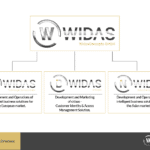Make vs. Buy – Reconsidering the vertical integration in IT
Digitalisation covers all economic sectors, creates new markets and, above all, changes customer behaviour at a rapid pace. Today, everything is expected to be made available at all times and in all places. Customers want tailor-made products and services that can be accessed via all channels.
In order to keep pace with this development, companies need powerful systems and digital platforms. However, many companies are not able to do this on their own, as they often lack the technological skills required for the new fields of cloud, artificial intelligence and digital marketing.
In short, doing everything yourself does not help.
Decision criteria: Customizing and competitive advantage
The following diagram provides assistance in deciding how to classify software solutions and services on the basis of the criteria Customization, i.e. the need for individual customization and the associated effort, in relation to the competitive advantage resulting from the software solution.

| Quadrant | Description |
|---|---|
|
Commodity Software |
Software that is usually used without significant customizations, e.g. office software. The use of this software is mandatory. Competitive advantages do not arise, because even market competitors have similar systems. |
| Fi/CO – ERP Services |
Enterprise Resource Planning Software for a very good support of the commercial corporate management. However, the problem is as follows: the more extensive the business processes are to be supported, the greater the customizing effort. The competitive advantage is not significant. |
| Added Value / Special Software |
Mostly used in combination with own innovations to use services that are not part of the core business. Examples: Customer Identity and Access Management Solutions, Navigation Services, Address Services, CAD Software, Computing Libraries |
| Own innovations |
Software that makes it possible to offer individual, unique services for customers and products. For example Collaboration platforms for direct customer contact or Web APIs for services that third parties can easily use. |
With this presentation, the decision is basically very simple, if it were not for the usual pitfalls:
Products are not familiar: Before the Internet age a not insignificant problem. However, today there are very good research possibilities and with a targeted search good solutions can be found. The effort for the comparison is always less compared to the conception of a solution.
The product offers much more than we currently need: That’s reassuring overall, obviously, we were thinking about features that could make a difference at a later date. The opinion that a short-term in-house development saves money is usually not correct, because the further development and maintenance of the software could mean unnecessary effort and knowledge must be permanently available even in fringe areas.
This software can be developed quickly with OpenSource: This is a very good argument, but it only makes sense for own innovations, because this software brings competitive advantages and customization is advisable for the reason. For commodity software or special software, this is usually not a sensible approach due to the continuous effort and time required.
The presented product offers advantages, but we have already implemented a solution: Replacing one solution with another only makes sense if permanent resources are needed to further develop the system i.e. if the features of the solution will soon become inadequate. However, this approach is usually associated with hidden IT costs that block the focus on the core business.
These arguments sometimes make it very difficult to come to the best possible decision. If these statements were objectively evaluated, e.g. with an AI algorithm, the human factor would not come into play so strongly. Why should you develop software yourself if software services already exist that have this functionality?
In fact, three top reasons for standard software can actually be identified, which especially apply to software with minimal customization effort.
1. Shorter time-to-market and higher budget security
The development effort, as well as the customization and integration effort, are the driving factors when it comes to time and costs.
If software has standard interfaces, the integration effort is usually low. The software is then basically replaceable. If software can be used out-of-the-box, the time-to-market cycle is shorter and the costs are limited to licensing. A very good combination results when the software can be used as a cloud service because the operating costs become completely meaningless.
Only those who are in a position to quickly provide their customers with added value can secure competitive advantages. The opportunity costs, which are lost between the identification of the requirement and the productive implementation of the actual solution, often outweigh with in-house developments. This also raises the question of whether sufficient qualified personnel is available at all. Often one approaches such a project too vaguely and thinks that one can easily develop an adequate solution oneself and only notices at a later stage that dedicated expertise is needed which is not available during operation. If the necessary personnel are available, the in-house development is still linked to an enormous commitment of resources, which eats up a lot of time and money, especially in the initial phase.
If you decide on an ” out-of-the-box ” product, then not only is it possible to go live in a shorter time, but budget security is also guaranteed. The costs are calculable right from the start and there is no need to keep manpower on standby or to set a budget for the know-how training.
2. Operational management costs and further development are mostly underestimated
IT experts and a roadmap for the further development of this software are required for operational management and further development, otherwise further costs will quickly arise due to missed lifecycle management measures.
With this argument at the most, there is a lot to be said for straightening out the vertical integration and focusing in-house developments on “own innovations”.
A good software product offers mature functions, professional support and continuous updates without cost allocation.
There is hardly any serious discussion today about whether to invest in in-house development in the case of
- Commodity software, such as office packages or web conferencing systems
- Special software/services, e.g. for security or maps
- Software for financial accounting
Security products also include Customer Identity and Access Management (CIAM) solutions, which are becoming increasingly popular. In the past, this type of software used to be simple with login with user ID & password and a simple database. Many systems still have this status today. CIAM is however much more, it offers social logins, consent management according to GDPR, passwordless authentication, biometrics, SSO, protection of own web interfaces and a lot of user comfort. In general, they can be easily integrated into software solutions.
The following scenarios are compared using the CIAM solution, cidaas as an example:
- Own development of a strongly simplified basic variant only for the implementation of the user login.
- Development of a solution similar to an average CIAM
- Implementing cidaas
The following diagram CIAM Buy vs. Basic Login Make shows a purely cost-related comparison of a cidaas Essentials Plan, a cidaas Standard Plan and the in-house development of a basic login function for web-based applications. The individual development loses already at this consideration, because of the development costs and the costs for the operation in the enterprise in relation to the standard solution. The integration effort shown is comparatively low and is therefore not significant. The functional scope of the standard product is already much more extensive in these plans than the in-house development.

For very large companies the development of an in-house CIAM may be considered, which can be useful in rare cases. However, the initial development costs are extremely high and the implementation timeline is very late. The following diagram CIAM Make vs. Buy shows the cost distribution over four years. In this comparison, it is assumed that an average CIAM functionality will be developed. Cidaas Pro and Enterprise are based on Big Data technologies and AI and integrate modern biometric authentication methods, which would not be possible with the described effort.

In addition, it should not be overlooked that a customized software represents a snapshot of the previous business and in no way guarantees that it is future-proof without major development efforts.
3. Concentrate on your own core competencies
Information technologies (IT) have been developing rapidly for decades and while in the past IT support and then automation with IT were in the foreground, today new business models are being created, thanks to modern and efficient IT concepts.
On one hand there are more and better IT solutions for consumers and companies, on the other hand modern IT concepts have to be used for the own business development.
Digital transformation can only be successful if you let go of the old and dare new things. The focus should be on software solutions that can differentiate market players and promote your own business.
It is fundamentally advisable to integrate software services and products into these software solutions in this way in order to keep control of your own vertical integration and to create time-to-market and innovation.
As a product manufacturer, companies can create real added value with additional (IT) services. If a company is a service provider, the services must be efficiently aligned with the products.
Conclusion
The questions in IT have to be: What competitive advantages do we have if we develop and operate the software ourselves? How high is the integration and customization effort when selecting a software product? Which opportunity costs arise or the other way around, what could be meaningfully achieved instead of software development or operation?
Whenever you want to develop your own innovations for your products and services, custom developments are probably more effective. Obviously available IT services should always be used to keep an eye on vertical integration, costs and time-to-market.
Click here to learn more about Customer Identity and Access Management


